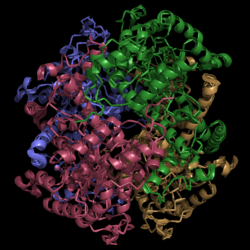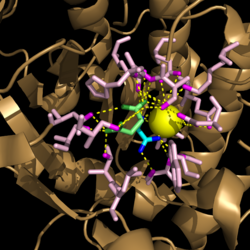Sandbox Reserved 1058
From Proteopedia
(Difference between revisions)
| Line 7: | Line 7: | ||
Isocitrate lyase plays a key role in survival of ''M. tuberculosis'' by sustaining intracellular infections in inflammatory respiratory macrophages. Used in the citric acid cycle, isocitrate lyase is the first enzyme catalyzing the carbon conserving glyoxylate pathway. This glyoxylate pathway has not been observed in mammals and thus presents a unique drug target to solely attack TB infections. | Isocitrate lyase plays a key role in survival of ''M. tuberculosis'' by sustaining intracellular infections in inflammatory respiratory macrophages. Used in the citric acid cycle, isocitrate lyase is the first enzyme catalyzing the carbon conserving glyoxylate pathway. This glyoxylate pathway has not been observed in mammals and thus presents a unique drug target to solely attack TB infections. | ||
===Mechanism of Action=== | ===Mechanism of Action=== | ||
| - | [[Image:TCA_Cycle.png| | + | [[Image:TCA_Cycle.png|500 px|left|thumb|'''Figure 1. Citric Acid Cycle with Glyoxylate Shunt Pathway.''' In several bacterial species, there is a carbon conserving gloxylate shunt pathway that converts isocitrate to malate in two steps instead of the usual five steps.]] |
==Protein Structure== | ==Protein Structure== | ||
Revision as of 17:43, 7 April 2015
Isocitrate Lyase from Mycobacterium tuberculosis
| |||||||||||


